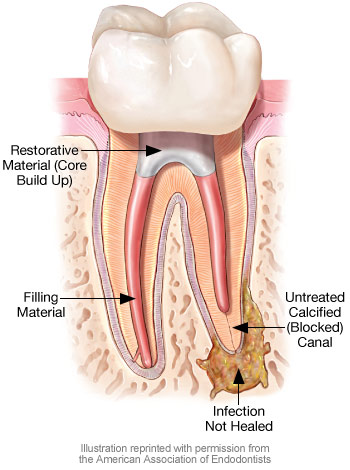Root Canal Retreatment
Why a second root canal treatment may be needed
Dear Doctor,
My dentist took a new set of x-ray pictures and noticed that a root canal treatment done many years ago is failing and he recommended retreatment. I have had no pain or other symptoms. Why is retreatment necessary and what is involved?

Dear Ray,
As occasionally happens with any dental or medical procedure, a tooth may not heal as anticipated after initial treatment for a variety of reasons:
- Narrow or curved root canals sometimes pose complications during the initial procedure.
- Complicated root canal anatomy (shapes and forms) went undetected in the first procedure.
- The placement of the crown or other restoration was delayed following the treatment, resulting in reinfection of the root canals.
- An inadequate seal of a restoration (filling) allowed recontamination of the inside of the tooth.
Some of these issues do not give rise to symptoms, but can give rise to chronic infection, often seen in an x-ray picture as a small black area around the end of an affected root. New problems too, can jeopardize a tooth that initially had successful endodontic (endo-inside, dontic-tooth) or root canal treatment.
For example:
- New decay can expose the root canal filling material to bacteria, causing a new infection in the tooth.
- A loose, cracked or broken crown or filling can expose the tooth to new infection.
- A tooth sustains a fracture of the crown or root.
The next question you may ask is — what will happen during pretreatment?
First, all options should be reviewed, together with the risks, benefits and alternatives. Assuming the tooth can be retreated, it will need to be “reopened”. A small hole will be made into the biting or chewing surface of the tooth to gain access to the root canal. In many cases, complex restorative materials — crown, post and core material — must be “disassembled” and removed to permit access to the root canals. The previous root canal filling materials are removed and the canals cleaned and carefully examined, usually requiring magnification and illumination, which includes searching for any additional canals or unusual canals that require treatment. After cleaning and shaping the canals they will be sealed and a temporary filling or crown placed.
If the canals are unusually narrow or blocked, there is a possibility that endodontic surgery may be necessary to treat infection and reseal the canal(s). Upon successful completion and healing of infection, a new crown or restoration will need to be placed on the tooth to protect and restore it to its full form and function.
How do I know if retreatment is the best choice and what are the alternatives?
Whenever possible, it is best to save your natural tooth. Retreated teeth can function well for years, even a lifetime. Advances in technology are constant and updated techniques may be used to save a tooth, which may not have been available when you had your first procedure. If non-surgical retreatment is not an option, then endodontic surgery may be considered. This involves making an incision to allow access to the end of the root(s). Endodontic surgery may also be recommended in conjunction with retreatment or as an alternative.
The only other alternative to retreatment or failing endodontics ultimately is extraction of the tooth. It will then need to be replaced with an implant, bridge or removable partial denture to restore chewing function and aesthetics and importantly, to prevent adjacent teeth from shifting. Because these options require surgery or dental procedures on adjacent healthy teeth, they can be more costly and time consuming than retreatment and restoration of the natural tooth. But this is a topic for another discussion.
Who performs root canal retreatment and what are the costs?
Endodontic or root canal retreatment can be more complicated and technically challenging than initial treatment, and is generally carried out by root canal specialists, “endodontists”, dentists who have taken specialty training in the diagnosis and treatment of root canal problems. Most modern endodontic procedures are performed with the use of microscopes to allow the proper degree of precision and sophistication needed to ensure success.
The cost varies depending on how complicated the procedure will be and the time that is needed. Teeth with multiple canals, like the back (premolar and molar) teeth will take more time especially if there are extra or unusually shaped canals. Restorations and filling material may also need to be removed to reaccess the root canal. Therefore, you can generally expect retreatment to cost more than the initial endodontic treatment. While dental insurance may cover part or all of the cost for retreatment, some policies limit coverage to a single procedure on a tooth in a given period of time. Check with your insurance company and dentist prior to retreatment to be sure of your coverage.
The bottom line is that you should review all the risks, benefits and alternatives of root canal retreatment with your dentist or endodontist. You've already made an investment in saving your tooth. The payoff for choosing retreatment should be a healthy, functioning natural tooth for many years to come.





